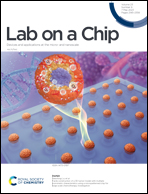Metasurface-enhanced infrared spectroscopy in multiwell format for real-time assaying of live cells†
Abstract
Fourier transform infrared (FTIR) spectroscopy is a popular technique for the analysis of biological samples, yet its application in characterizing live cells is limited due to the strong attenuation of mid-IR light in water. Special thin flow cells and attenuated total reflection (ATR) FTIR spectroscopy have been used to mitigate this problem, but these techniques are difficult to integrate into a standard cell culture workflow. In this work, we demonstrate that the use of a plasmonic metasurface fabricated on planar substrates and the probing of cellular IR spectra through metasurface-enhanced infrared spectroscopy (MEIRS) can be an effective technique to characterize the IR spectra of live cells in a high-throughput manner. Cells are cultured on metasurfaces integrated with multiwell cell culture chambers and are probed from the bottom using an inverted FTIR micro-spectrometer. To demonstrate the use of MEIRS as a cellular assay, cellular adhesion on metasurfaces with different surface coatings and cellular response to the activation of the protease-activated receptor (PAR) signaling pathway were characterized through the changes in cellular IR spectra.



 Please wait while we load your content...
Please wait while we load your content...